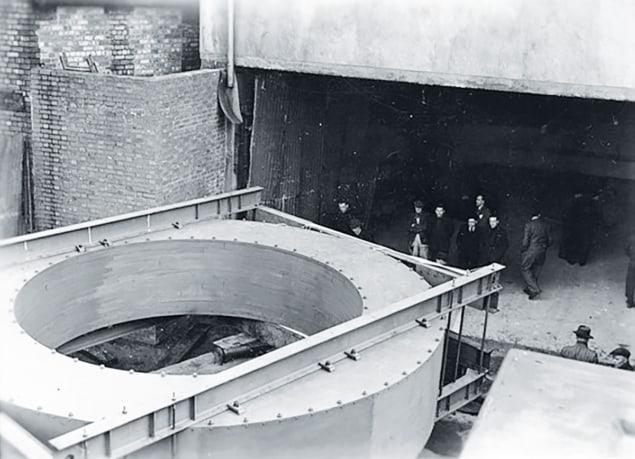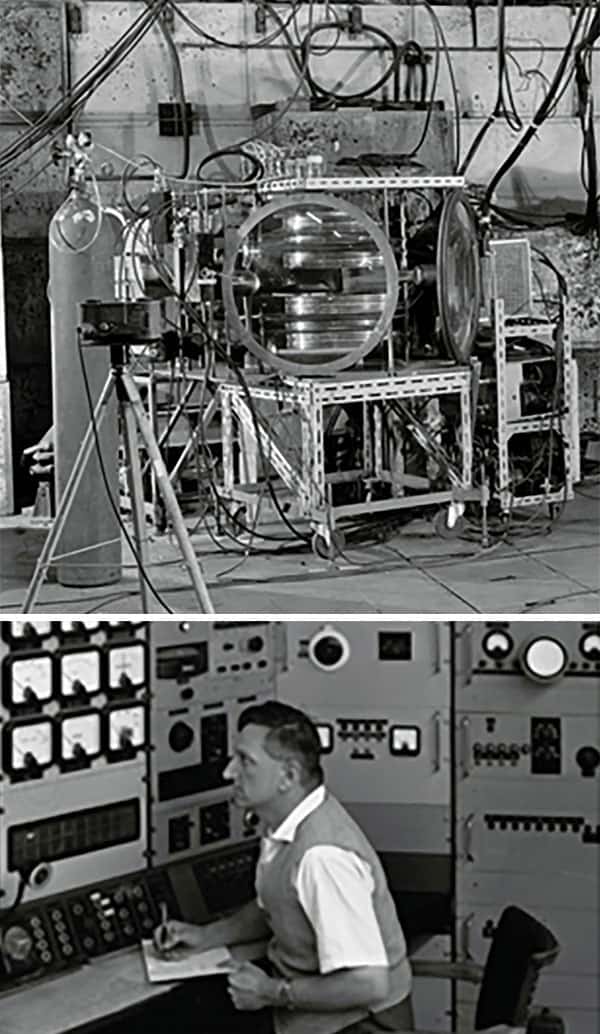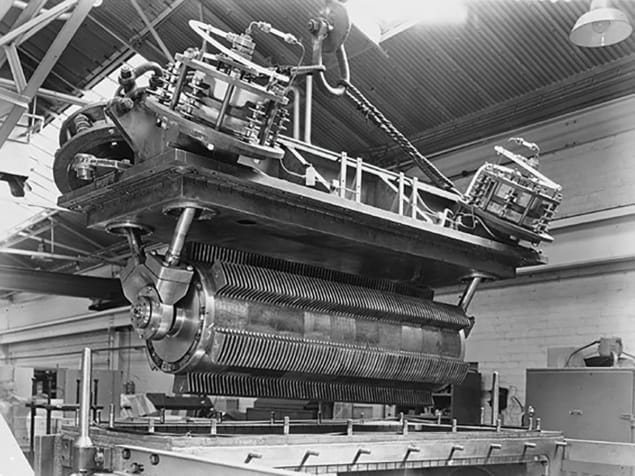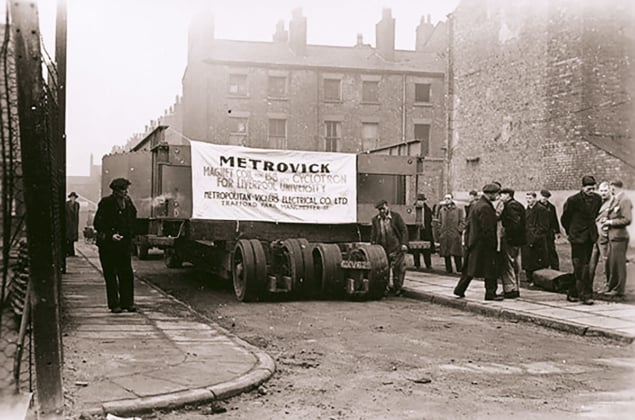The legacy of Liverpool’s forgotten synchrocyclotron
11 May 2022
Taken from the May 2022 issue of Physics World. Members of the Institute of Physics can enjoy the full issue via the Physics World app.
The University of Liverpool’s synchrocyclotron helped define physics in the 20th century, yet little trace of it remains. Rob Lea looks into the history of this lost machine
The Metropolitan Catholic Cathedral at the peak of Mount Pleasant in Liverpool, UK, represents a unique and unmistakable landmark in the city’s skyline. But unbeknown to many passing or visiting the wigwam-shaped building, beneath the steps and next to the crypt there was once a particle accelerator that played an important role in the evolution of experimental physics.
The synchrocyclotron, which operated from 1954 to 1968, was designed to use a single magnet to accelerate a beam of particles – originally protons, but subsequently pions and neutrons – to relativistic speeds around a circular track. During its first years of operation, it was the most powerful example of particle accelerator technology in operation in Europe. It paved the way for future machines, being the first of its type where researchers could extract an intense beam of particles and direct it to apparatus outside of the accelerator’s main body to perform experiments.
Despite its relative obscurity today, Liverpool’s synchrocyclotron played a major part in the rapidly evolving fields of particle and nuclear physics. It served as one of the last pieces of apparatus that practitioners of both disciplines could work on side-by-side before the experimental needs of these distinct areas of study diversified completely. Indeed, this machine provided a vital glimpse of the fundamental laws of the universe, supplying some of the first evidence that particles and their antiparticle counterparts can behave differently.
Chadwick and the synchrocyclotron
It’s impossible to tell the story of this accelerator without touching upon the renowned British physicist, James Chadwick, who won the 1935 Nobel Prize for Physics for his discovery of the neutron and worked on the Manhattan Project during the Second World War.
As Chadwick witnessed the culmination of his efforts on the atomic bomb in 1945, researchers in the US and the Soviet Union were discovering the “principle of phase stability”. This involved varying the frequency of the radio frequency (RF) electric field in a cyclotron to account for the relativistic effects that otherwise limited the energy of protons in an accelerator (see box). In short, it made it possible to develop much larger cyclotrons that could accelerate particles to near the speed of light.
The University of Liverpool already had a 37-inch diameter cyclotron. But according to John Riley Holt – a fellow physicist and student of Chadwick at Liverpool who wrote an article about him in 1994 (Notes and Records of the Royal Society of London 48 299) – Chadwick had bigger plans than just renovating and repairing this machine. Instead, he intended to build a much larger facility that would mean his lab could compete with any other in the world. In 1947 plans were drawn up by Chadwick and the team at Liverpool, for a frequency-modulated 156-inch diameter cyclotron that would provide protons with an energy of 400 MeV. Construction time The synchrocyclotron’s single magnet being slowly moved into place partially underground to help with radiation shielding. (Courtesy: The Victoria Gallery & Museum: University of Liverpool)
Construction time The synchrocyclotron’s single magnet being slowly moved into place partially underground to help with radiation shielding. (Courtesy: The Victoria Gallery & Museum: University of Liverpool)
 Construction time The synchrocyclotron’s single magnet being slowly moved into place partially underground to help with radiation shielding. (Courtesy: The Victoria Gallery & Museum: University of Liverpool)
Construction time The synchrocyclotron’s single magnet being slowly moved into place partially underground to help with radiation shielding. (Courtesy: The Victoria Gallery & Museum: University of Liverpool)Funding for the new accelerator was granted to the university in 1946 in acknowledgment of the work that Chadwick and other Liverpool physicists did on the Manhattan project. “When you look and see the deprivation after the war, this machine had priority money from the government, so it’s clear how important it was,” says Mike Houlden, a retired physicist from the university who first studied there during the final years of the accelerator’s operation. The synchrocyclotron itself cost £500,000, and the building that housed it is listed as having cost £235,000 – a considerable investment in a country heavily hit during the war. Taking inflation into account, the synchrocyclotron would have cost the equivalent of almost £28.5m today.
“The country was still recovering from the war, so it was amazing that the government had prioritized building a particle accelerator in 1947 and 1948,” Houlden adds, pointing out an image of the Liverpool skyline at the time of the accelerator’s construction in 1951 that shows cranes in the city still repairing damage from German bombing.
Peter Rowlands, a physicist currently at the University of Liverpool, has written a history of the department (125 Years of Excellence, The University of Liverpool Physics Department 1881 to 2006). In the book, he describes how the land on Mount Pleasant, where the Metropolitan Cathedral was under construction, was selected for the site of this new synchrocyclotron and leased from the Roman Catholic Church.
According to Rowlands, it was Joseph Rotblat – Liverpool’s acting director of research in nuclear physics at the time – who had the idea of housing the machine in a chamber cut into the mound on which the cathedral crypt was built after a visit to the catacombs in Rome. Being partially buried would help with radiation shielding, as well as the 30-tonne door, and walls comprised of nearly 1.8 m of concrete, behind which was approximately 3.7 m of rock with a 1.5 m thick ceiling.
Construction began in 1948 but despite playing such a prominent role in pioneering and planning the synchrocyclotron, Chadwick would not directly use the machine. Holt wrote that Chadwick’s decision to leave Liverpool that same year to take a position in Cambridge required much “heart-searching”, and suggests that it was the achievement of establishing an important center for nuclear research that gave the physicist the most satisfaction.
The synchrocyclotron was completed four years later in 1952, with its first beam achieved in April 1954. Creating a circulating beam of particles was an undeniable achievement, but researchers at Liverpool were about to make a giant leap that would unlock a wealth of further discoveries.
Cyclotron, synchrocyclotron, synchrotron
In a conventional cyclotron, charged particles are accelerated from a central point outwards in a spiral, within two D-shaped electrodes – or “dees” – that have a gap between them. A static magnetic field bends the charged particles in a semicircular path within each dee, while a regularly alternating radio frequency (RF) electric field is applied across the gap to accelerate the particles. After each jump between dees, the semicircular path has a bigger radius because of the speed increase, resulting in the spiral.
The major disadvantage of this basic type of cyclotron is that it can only accelerate particles to a fraction of the speed of light. Once particles start to reach relativistic speeds, the beam goes out of phase with the electric field and cannot be further accelerated. This is where the synchrocyclotron comes in.
In this derivative of a cyclotron, the frequency of the RF electric field is continuously decreasing to compensate for the relativistic effects of the particles as they approach the speed of light. A synchrocyclotron also only needs one dee as strong electric fields are not required to produce large amounts of acceleration because the number of revolutions the particles can take is not restricted as in a cyclotron (the other end of the oscillating voltage is connected to earth).
While cyclotrons, in general, have been surpassed by synchrotrons – giant ring-shaped accelerators – for high-energy particle research, they are still frequently used in, for example, medical and nuclear physics because they are compact sources of particle beams.
Making strides and breaking laws
Technologically speaking, perhaps the most significant achievement at the synchrocyclotron was the extraction of 10% of the circulating beam particles – in this case, protons – from the machine, with an energy of 383 MeV.
Carried out by Albert Crewe, John Gregory and Mike Moore in December 1954 (Proceedings of the Royal Society A 232 242), it was the first time a beam had ever been extracted from a synchrocyclotron. Getting a beam out was important because it now allowed experiments to be carried out, even if just 3% of the extracted beam made it through a channel leading from the accelerator to the measuring apparatus (Nature 175 1012). “You can keep sending the stuff round and round. But unless you can get it out, hitting something, it’s no use,” says Rowlands.
Being able to extract a beam also reduces the amount of apparatus that has to be squeezed into the accelerator itself. “If you can pull the beam out, you don’t have to put your equipment inside the accelerator for the beam to hit, so you can do a huge number of experiments using much bigger equipment,” says Holden. Having achieved this technological leap, Liverpool’s synchrocyclotron would be used to make a more fundamental breakthrough at the heart of how matter behaves. Down time Workers at the University of Liverpool’s Chadwick Lab sit on the synchrocyclotron’s massive single magnet. (Courtesy: The Victoria Gallery & Museum: University of Liverpool)
Down time Workers at the University of Liverpool’s Chadwick Lab sit on the synchrocyclotron’s massive single magnet. (Courtesy: The Victoria Gallery & Museum: University of Liverpool)
 Down time Workers at the University of Liverpool’s Chadwick Lab sit on the synchrocyclotron’s massive single magnet. (Courtesy: The Victoria Gallery & Museum: University of Liverpool)
Down time Workers at the University of Liverpool’s Chadwick Lab sit on the synchrocyclotron’s massive single magnet. (Courtesy: The Victoria Gallery & Museum: University of Liverpool)In particle physics, CPT symmetry suggests that any fundamental theory must be invariant under the combined operation of three symmetries: charge conjugation (C) or transformation between particle and antiparticle; parity (P) or inversion of the coordinate system; and time-reversal (T). The theorem was first put forward in 1954, but just a few years later there were already hints of CPT violation, sparking the idea that this symmetry doesn’t always hold.
By 1956 Tsung-Dao Lee of Columbia University, and Chen Ning Yang, then at the Institute of Advanced Study at Princeton (though he was a visitor at Brookhaven National Laboratory) predicted that parity conservation could be violated between particles and antiparticles in the weak interaction of nuclear beta-decay (the emission of an electron and antineutrino when a neutron transforms into a proton in an unstable nucleus). Within months, physicist Chien-Shiung Wu and her team at Brookhaven provided experimental confirmation.
But to confirm the violation of charge conjugation, physicists needed to see a violation in the conservation of charge particle-antiparticle symmetry when positively charged muons decay into an antielectron (otherwise known as a positron), a neutrino, and an antineutrino. This was an investigation to which the power of Liverpool’s synchrocyclotron was ideally suited, but the competition to discover C violation was intense, with Wu’s team at Brookhaven and physicists at Columbia’s Nevis Cyclotron Laboratory also hunting for it.
“The experiment was done in two stages and required pions from the beam to hit a carbon target, producing muons which decayed to positrons, which then produced polarized photons,” Rowlands explains. “The first result in 1957 showed the positrons had spins aligned preferentially to the direction of motion, which confirmed the specific mathematical nature of the weak interaction.” Heart of the machine Top: The synchrocyclotron’s control chamber in 1965. Above: University of Liverpool staffer Bert Chester operates the control desk in 1962. (Courtesy: The Victoria Gallery & Museum: University of Liverpool)
Heart of the machine Top: The synchrocyclotron’s control chamber in 1965. Above: University of Liverpool staffer Bert Chester operates the control desk in 1962. (Courtesy: The Victoria Gallery & Museum: University of Liverpool)
 Heart of the machine Top: The synchrocyclotron’s control chamber in 1965. Above: University of Liverpool staffer Bert Chester operates the control desk in 1962. (Courtesy: The Victoria Gallery & Museum: University of Liverpool)
Heart of the machine Top: The synchrocyclotron’s control chamber in 1965. Above: University of Liverpool staffer Bert Chester operates the control desk in 1962. (Courtesy: The Victoria Gallery & Museum: University of Liverpool)In his history of the Liverpool physics department, Rowlands relays the frantic time in which this initial experiment was conducted. “The experiment was done in a hurry over a three-day period of virtually non-stop work,” Rowlands writes.
The aim of the experiment was to determine whether the mathematical nature of beta-decay couplings was a scalar and tensor mixture as was supposed. This scheme would mean that the positrons from positive muon decay should have spins pointing in the opposite direction to their direction of motion.
Determining the direction of the spins required a huge electromagnet, but even when the experimental result was collected the team had further sleuthing to do before it was confirmed. “When a result was finally obtained, the researchers suddenly found they didn’t know which way round the magnet was wired!” Rowlands describes. Determining which way the magnet faced was crucial to determining the direction of the particles’ spin.
Rowlands explains how this led to arguments raging at 3.00 a.m. among Holt’s team about north magnetic poles, north-seeking poles, Fleming’s left-hand rule, and other aspects of physics. In an attempt to settle the debate one of the team took out a small magnetic compass and held it to the magnet, but the arguments continued. Finally, a team member went outside the lab and pointed to the pole star, showing that the compass was actually pointing due south – the magnet had changed the orientation of the compass.
The team had therefore found that the positrons’ spins were in the direction of motion, meaning that the mathematical nature of beta-decay couplings was actually vector and axial-vector, rather than tensor and scalar. Rowlands calls this “a result of immense significance for the fundamental nature of the weak force”, adding that it was arrived at via a combination of one of the most sophisticated machines available to scientists at the time and an ancient navigation technique.
The second stage of the experiment, done in 1958, using both positive and negative muons. It showed that the polarization of the positrons and electrons, which resulted from the decays of positive and negative muons, were opposite, therefore indicating C violation. “The crucial thing here was that this showed that particles, positive muons, and their antiparticles, negative muons, behave in different ways when they decay,” explains Houlden. “A completely important result as it shows that there is a fundamental difference between particles and antiparticles.”
A synchrocyclotron’s legacy
The end of Liverpool’s synchrocyclotron came in 1968. The reasons for its shutdown were simple – the technology had been surpassed and the power demands of the machine alone amounted to over £27,000 in 1961 (the equivalent of over £500,000 today).
Many of the researchers who had cut their teeth on the accelerator had already moved over to the 600 MeV synchrocyclotron at CERN in Geneva, which had begun operations in 1957. Even physicists working at the University of Liverpool were doing their experiments at CERN. “[Liverpool’s synchrocyclotron] was completely out of date. Everybody wanted to go to CERN and work on the new and improved facilities available there,” Houlden explains. “So the 156-inch synchrocyclotron’s life just came to a natural end.” Final piece The synchrocyclotron’s rotating condenser here shown in the factory is one of the few pieces of the machine that still exists, although it is currently in storage. (Courtesy: The Victoria Gallery & Museum: University of Liverpool)
Final piece The synchrocyclotron’s rotating condenser here shown in the factory is one of the few pieces of the machine that still exists, although it is currently in storage. (Courtesy: The Victoria Gallery & Museum: University of Liverpool)
 Final piece The synchrocyclotron’s rotating condenser here shown in the factory is one of the few pieces of the machine that still exists, although it is currently in storage. (Courtesy: The Victoria Gallery & Museum: University of Liverpool)
Final piece The synchrocyclotron’s rotating condenser here shown in the factory is one of the few pieces of the machine that still exists, although it is currently in storage. (Courtesy: The Victoria Gallery & Museum: University of Liverpool)Meanwhile, others who worked with the Liverpool accelerator would move to the 5000 MeV electron synchrotron at the National Institute for Research in Nuclear Science (NINA) in Daresbury, UK. Rather fitting, as Holt says in his article because it was the success of Liverpool as an important center of nuclear research that led to the establishment of NINA in 1962.
Houlden adds that Liverpool’s machine was at the very peak of what synchrocyclotrons with a single magnet could achieve. Later machines, such as the one in CERN, would use a ring of magnets rather than just the one to guide a beam of particles through a circular path and give them an accelerating “kick” as they pass.
Not only did the Liverpool machine provide a vital experience that physicists would carry with them to its successors all over the world, but it also played an important part in establishing the university as a world leader in physics. Indeed, Rowlands suggests that Liverpool’s physics department may not exist at all today were it not for Chadwick bringing the synchrocyclotron to the city. “I think it kept Liverpool at the forefront of physics during a crucial period,” Rowlands explains. “The department would have still existed in the 1960s, but when cut-backs came it could have suffered because of its proximity to Manchester if it was reasoned, ‘why do we need Liverpool and Manchester universities doing physics?’ ”
Out of action: other defunct or lost accelerators
CERN’s 600 MeV Synchrocyclotron was the first particle accelerator at the now-famous site and came into operation in 1957. It made its first big discovery in 1958, providing clear evidence of the rare decay of pions into electrons and neutrinos. The synchrocyclotron put CERN on the map but was closed down in 1990 and made into a visitors exhibition.
The Superconducting Super Collider in Texas, US, was to be a powerhouse of particle-physics research. Set to be 87 km in circumference, it would have dwarfed the 27 km-circumference Large Hadron Collider (LHC) at CERN. Construction began in 1991 but was canceled in 1993 for financial and political reasons, despite 22.5 km of tunnels being dug and $2bn spent. The tunnels are now blocked off, likely flooded, and the site was abandoned for nearly two decades before being bought by a chemicals company.
Tevatron at the Fermi National Accelerator Laboratory in Illinois, US, was the world’s highest-energy particle accelerator for two decades before the LHC came along. The 6 km synchrotron became operational in 1983, and its many achievements include the discovery of the top quark in 1995. It was shut down in 2011 because it could not compete with the LHC. The Main Injector ring, located in a separate tunnel, is still in operation and is Fermilab’s most powerful particle accelerator even today. While mostly unused, a portion of the Tevatron tunnel still transfers the beam from the Main Injector accelerator to experimental areas such as the Fermilab Test Beam Facility.
BESSY I was a synchrotron built-in 1981 in Berlin, Germany, that could produce 200–800 MeV electrons within its 60 m circumference ring. It was decommissioned in 1999 as it had become outdated, but rather than being simply discarded, it was recycled. In an effort to promote collaborative scientific and technological excellence in the Middle East, BESSY I was moved to Allan, Jordan, where it became the region’s first synchrotron light source, SESAME. Developed under the auspices of UNESCO, SESAME was officially opened in 2017, after an upgrade to a 2.5 GeV light source, 133 m in circumference.
Mostly lost to history
Despite its importance to both physics and the city, little remains of Liverpool’s synchrocyclotron today. Due to their radioactivity, many parts of the machine were likely disposed of in a government landfill site, Houlden suggests, adding that many non-radioactive parts were sold for scrap.
The only parts of the accelerator for which we can be sure of their resting place are its rotating condenser and frame. Wendy Simkiss, a curator at the World Museum in Liverpool, says that these parts were acquired by the museum in 1975, saving them from the scrap heap. From 2014 they were temporarily on display at the University of Liverpool’s Victoria Gallery and Museum as part of the physics exhibit, but since at least 2018 the synchrocyclotron’s frame and condenser have been in storage out of sight of the public.
But apart from those pieces – as well as some scattered mentions in the histories of Chadwick, and the memories of storytellers and historians like Rowlands and Houlden – little remains to remind people of the existence of this vital step in the development of particle physics. Nor are there many reminders that these developments happened in Liverpool, a city usually renowned for its fierce and justified pride in its history.
“There’s no trace of the 156-inch synchrocyclotron. Not even a little blue plaque,” Houlden concludes. “If you didn’t know about it, you would never even know that it was there.
Rob Lea is a science writer based in Liverpool, UK, Twitter @sciencef1rst
from physicsworld.com 13/5/2022

Δεν υπάρχουν σχόλια:
Δημοσίευση σχολίου